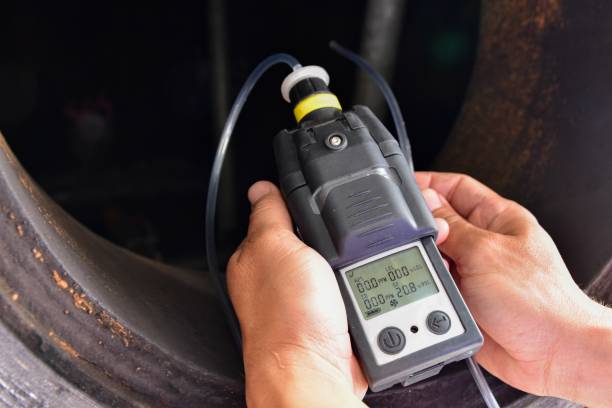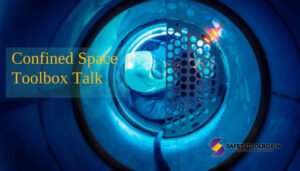Confined Space: Every year thousands of people lost their lives during working in Confined Space. The majority of accidents are caused during working in Vessels, tanks, manholes, sewage sumps, sewers, trenches, borewells, and so on. The reason behind accidents is allowing the person to enter confined spaces without carrying out atmospheric tests or lack of awareness about the Hazard in it.
It is never be defined based on the volume of tanks or vessels it could be very giant like a submarine, ships, chemical storage tanks, or silos.
What is Confined Space?
- It is a Space where the limited opening for Entry or Exit (one opening usually)
- Space is not designed for the working of humans for a long time
- It has sufficient space to perform any kind of work (it should be large enough)
In short, it is a space where the risk to human life is high due to oxygen deficiency, availability of flammable gases, toxic gases, or electrical hazards
Who can work in Confined Space?
Only a certified person who has valid authorization for working in a confined space can be allowed to work in such an area
How to get Authorization for working in a confined space?
The entire procedure for authorization is site-specific as below
- Required basic training of confined space with plant-specific requirements for work in confined space, it also includes what to do, what not to do
- Followed by examinations (Theoretical, Practical), the only person who obtained required marks in examinations got badges of Authorized for confined space
- Apart from this, he has been trained on permit requirements for confined space
Tips: It can link with the Id card of your company employee/contractor. Id card of an authorized person can be marked with “Authorized Confined Space”.
Who is authorized for Confined Space attendants?
- Anyone who has sufficient experience and knowledge for working in a confined space
- He has a knowledge of operating and testing of gas detector
- Who is successfully passed training of confined space
- Who knows rescue procedure for confined space
- Who is gone through emergency handling training
- Who has the ability of writing so he can easily write details of the entrant in permit
Hazard of Confined Space
- Health Hazard: Oxygen Deficiency
- Fire Hazard due to availability of Flammable gases
- Health Hazard: Presence of Toxic gases
- Electrocutions: Due to leakages of electricity
- Fall hazard: Poor illuminations
- Health Hazard: Sudden release of material(gas/chemical) while working

Ensure the following precautions while working in Confined Space
- Ensure permit for working in confined space must be taken before starting of work
- Attendant and entrant both must be competent (Authorized) for work in this kind of spaces
- Ensure atmospheric test is carried out before approval of the permit. the test must include the presence of Oxygen (between 19.5% to 21.5%), LEL (to ensure availability of flammable gases- Nil), H2S (Less than 10 ppm), No Presence of any toxic gases like Carbon monoxide (less than 50 ppm), etc. or any other heavier gases which may be available in confined space.
- The temperature in the confined space should be less than 40o C for safe and comfortable working. Less air movement and high temperature lead to exhaustion, dizziness, or heat stock
- An attendant must be present outside of the confined space till the entire work is completed and maintain records of the entrant in permits
- An attendant should have to communicate (verbal or Visual) continuously with the entrant to ensure they are safe during work
- All entrants must be aware of the hazard associated with their works
- A person can work for a maximum of 15 min in a one go-to avoid risks related to exhaustion
- Make sure vessel must be properly cleaned from chemicals or gases before entering
- To avoid the formation of ignitable atmosphere in vessels always use inert gases (nitrogen, Carbon dioxide, etc.) for removing (cleaning) flammable chemicals or gas
- Use SCBA sets or airline breathing apparatus for working in a contaminated atmosphere
- Inspect SCBA and airline breathing apparatus before entering in confined space and maintain a record of inspections
- Always keep gas detector in confined space or provide personal gas detector to the workers (entrant) to get alert during the unfavorable condition
- The gas detector must be calibrated half-yearly and its record should be maintained
- Electrical supply must be isolated before entering vessels, reactors, storage tanks, etc.
- Uncontrolled liquid chemical/ hot water/ steam/vapor/rotating equipment can harm workers if operated while a person working in vessels/reactor. All potential sources must be isolated using LOTO & blinding procedures should be followed at valves/ transfer pumps/ pipes/ rotating equipment etc.
- Nonentry rescue kit required for evacuation of entrant during emergency without entering in confined space. rescue kit includes Tripod, K-pod, Davit arm winch, retractable fall arrestor, lifeline, safety belt, etc.
- Condition of winch (used in k-pod/Tripod) and retractable fall arrestor must be checked before every use
- The winch must have a valid certification from a competent agency or manufacturer
- Make sure that the rescue kit must be strong enough to withstand the weight of the entrant
- An attendant must be trained (Competent) enough for the use of rescue arrangements during an emergency. It is observed that 30% of death in confined space happened during rescue attempts
- During accidents always use non-entry rescue arrangements for the rescue of entrant. Always use self-contained breathing apparatus (SCBA) for entring in confined space during the rescue of entrant
- Adequate lighting (illumination) is required for working in a confined space. always use 12-24 V Ac or battery-operated flameproof lights in confined space
- All manholes of tanks/vessels/reactors should be opened for natural ventilation. In case of limited manhole use mechanical(forced) ventilation for air movements i.e blowers or exhaust fans
- Before any kind of hotwork in a confined space, make sure all flammable material should be removed
- Inform emergency rescue team before confined space entry which includes first-aiders, doctors, safety team,admin ream, etc,
- Always provide suitable clothing to workers according to the working atmosphere in vessels
- Required Marking of “Confined space permit required for the entry” on all confined spaces in English and local language to avoid unauthorized entry without permit
- Mark appropriate signages on tanks to understand the hazard of material available in the tank
- Always use a ladder for entry in confined spaces which has depth more than or equal to 4 feet
- If permanent steps are available for entry in confined space always ensure the stability of steps before stepping on the ladder
- Do not eat or drink in a confined space
- Use appropriate PPE such as safety belt, safety helmet, mask (cartridge, dust, etc.), SCBA set, hand gloves, aprons, earplug, etc. according to work
For more Safety toolbox talk click here…

Thanks in sharing very informative concerns in confined space mitigation requirements and aspects handling rescue
Please to be kindly,in items safety Heath in confined space most of the company in my country Nigeria,, have been using over 50 minutes inside confined space which is an hazard to personal thanks Joe
In section : “How to get Authorization for working in a confined space? ”
It talks about skill, knowledge and experience. It must also include physical fitness, mental fitness and medical fitness at time of doing job.
Thank you for sharing very important and life saving safety precautions in confined space entry.